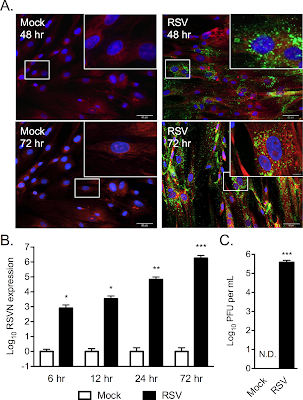There is a lot of cross talk between neurons and glia. In neuro-immuno and neuro-degenerative diseases this cross talk is dysregulated. Robust neuron-glia co-cultures are needed for drug discovery and basic research.Here is a study that references use of co-culturing to study the interactive effects of the viral protein HIV-1 Tat lipopolysaccharide (LPS) on enteric glia and neurons.
Here is a study that references use of co-culturing to study the interactive effects of the viral protein HIV-1 Tat lipopolysaccharide (LPS) on enteric glia and neurons. In order to optimize the co-culturing our
Media, Coatings and
GDNF growth factor are used.
Joy Guedia, Paola Brun, Sukhada Bhave, Sylvia Fitting, Minho Kang, William L. Dewey, Kurt F. Hauser; Hamid I. Akbarali. HIV-1 Tat exacerbates lipopolysaccharide-induced cytokine release via TLR4 signaling in the enteric nervous system. Scientific Reports 6, Article number: 31203 (2016) doi:10.1038/srep31203.
Figures: (A) Representative confocal microscopic images of enteric β-III tubulin (green) and glial fibrillary protein (GFAP- red) showing the presence of neurons and glia isolated from the adult mouse LMMP. (B) IL-6 release from isolated mouse neuron/glia co-culture treated with 100 nM Tat, 100 ng/ml LPS or Tat+ LPS for 16 h measured by ELISA. (C) IL-1β release from neuron/glia co-culture treated with 100 nM Tat, 100 ng/ml LPS and Tat+ LPS for 16 h measured by ELISA (D) mRNA expression of TNF-α of mouse LMMP treated with 100 nM Tat, 100 ng/ml LPS and Tat+ LPS for 16 h. (E) TNF-α release from mouse LMMP treated with 100 nM Tat, 100 ng/ml LPS or Tat+ LPS for 16 h measured by ELISA.
Protocol: Myenteric neurons and glia were isolated as described recently41. Briefly, after euthanizing mice, the ileum was immediately removed and placed in ice-cold Krebs solution (118 mM NaCl, 4.6 mM KCl, 1.3 mM NaH2PO4, 1.2 mM MgSO4, 25 mM NaHCO3, 11 mM glucose and 2.5 mM CaCl2) bubbled with carbogen (95% O2/5% CO2). The ileum contents were discarded by passing Krebs solution using a syringe. The ileum was then divided into short segments which were threaded longitudinally on a plastic rod through the lumen and the longitudinal muscle containing the myenteric plexus (LMMP) strips were obtained using a cotton-tipped applicator. LMMP strips were rinsed three times in 1 ml Krebs and gathered by centrifugation (350 × g, 30 sec). LMMP strips were then minced with scissors and digested in 1.3 mg/ml collagenase type II (Worthington) and 0.3 mg/ml bovine serum albumin in bubbled Krebs (37 °C) for 1 h, followed by 0.05% trypsin for 7 min. Following each digestion, cells were triturated and collected by centrifuge (350 x g for 8 min). Cells were then plated on laminin (BD Biosciences) and poly-D-lysine coated coverslips in Neurobasal A media containing B-27 supplement, 1% fetal bovine serum, 10 ng/ml glial cell line-derived neurotrophic factor (GDNF, Neuromics, Edina, MN), and penicillin/streptomycin. Half of the cell media was replaced every 2–3 days with fresh complete neuron media.
We welcome your questions input on co-culturing. Pete Shuster, CEO and Owner , Neuromics-pshuster@neuromics.com or 612-801-1007.



























